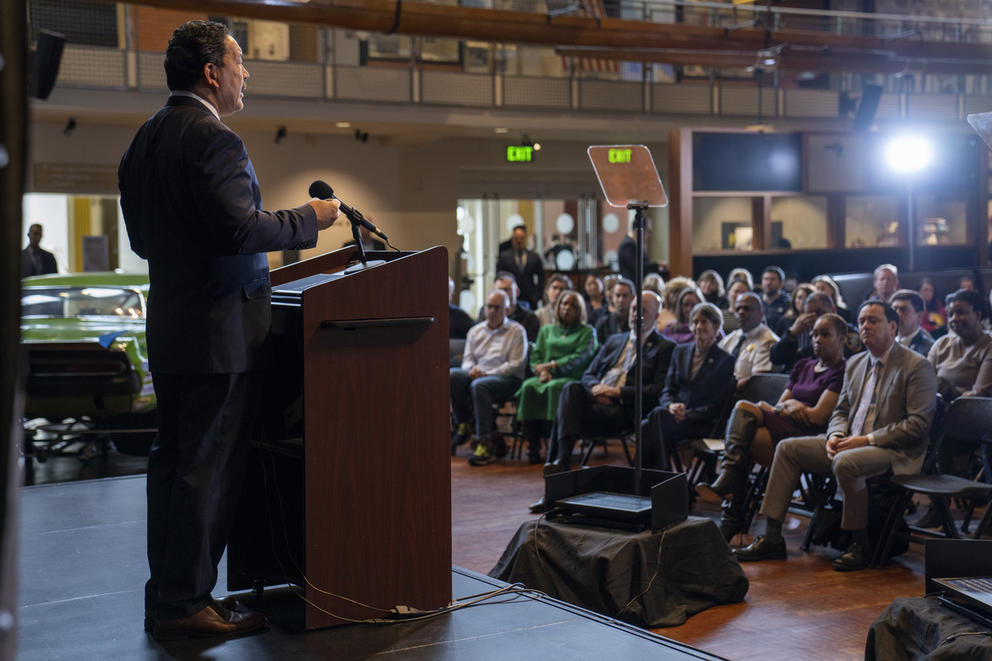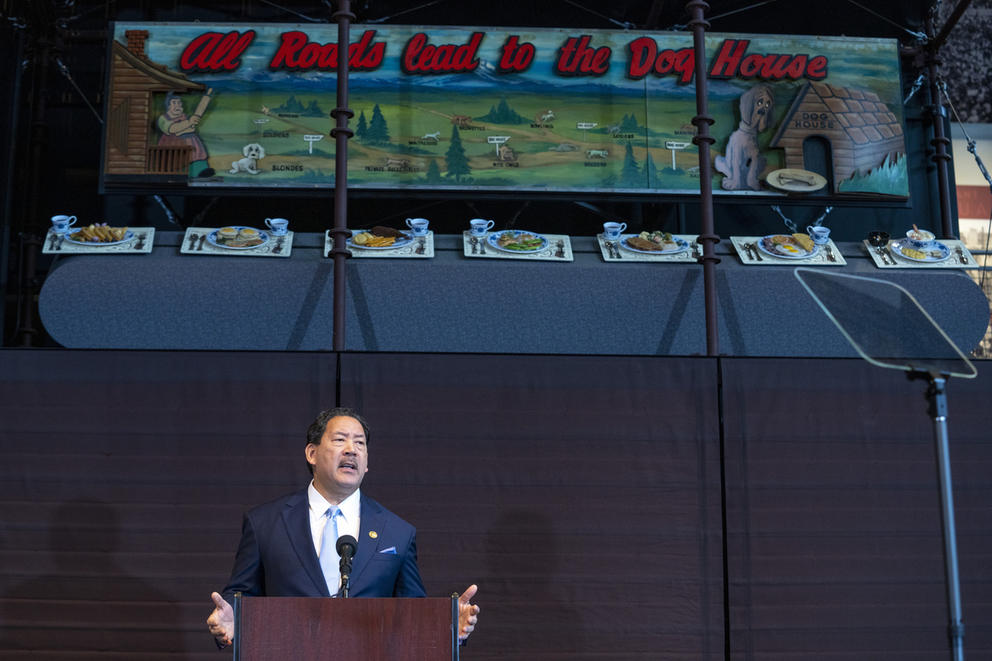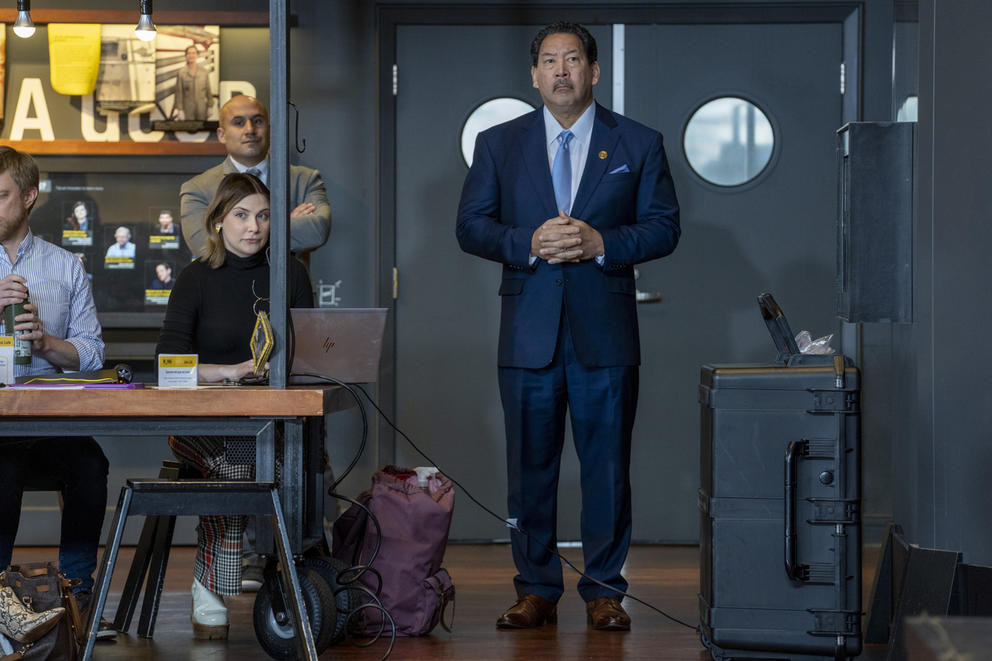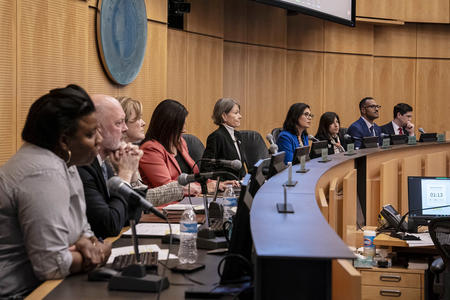“In this former timber town, on the ancestral lands of the Duwamish and Coast Salish people, our history tells us that it’s innovation and new ideas that break through logjams and cultivate hope,” Harrell said Tuesday.
In his tallying of 2023 accomplishments, the mayor cited the newly launched CARE Department, which sends trained mental health professionals alongside police officers to respond to some public emergencies. He also pointed to the long-delayed update of Seattle’s Industrial and Maritime Zoning plan; the city’s updated tree protections ordinance; a revamped plan to double the units in the delayed Fort Lawton affordable-housing plan; and work on electrifying trucking and leaf blowers.
Crime and public safety
On public safety, Harrell touted Seattle’s 7% overall drop in crime in 2023, along with a 6% drop in major violent crimes and 10% drop in property crime. But the city’s 72 homicides last year set a new 30-year high, and Harrell acknowledged the work needed to increase safety and reduce the number of guns on the street. “Last year, our officers recovered over 1,500 guns, a record for our city. I will repeat: There are too many guns in this country, on our streets, and in the wrong hands.”
To that point, Harrell said Seattle will continue supporting Olympia’s efforts on gun regulations. Seattle’s 2024 budget includes more than $1 million to experiment with new police technology such as an acoustic gunshot detection system (a technology that has drawn ire in other cities for being costly and questionably effective). The mayor also plans to continue working on police recruitment, a central focus of the first half of his term. SPD is still down about 375 officers from its 2017 peak of 1,424.
During Tuesday’s speech Harrell announced plans to host a public forum on public safety in March to hear directly from Seattle residents on the issue.
Harrell framed the drug crisis as both a public safety and public health issue. On the public safety front, he said SPD officers have focused on arresting dealers, while connecting drug users to case workers in the wake of last September’s passage of a new drug law. He also highlighted Seattle Fire’s new Health 99 overdose response team and the city’s plans to spend $7 million on a new post-overdose recovery center.
Economic recovery
Downtown and citywide economic recovery has been a central theme of Harrell’s first two years as mayor. On Tuesday, he talked about implementation of his 46-point Downtown Activation Plan, which includes everything from repurposing vacant storefronts for art installations and pop-up stores to converting underutilized offices into housing. On that latter idea, Harrell announced he will be sending legislation to the City Council in March to help incentivize office-to-residential conversions.
Harrell also said his administration has an “urban development vision for a new kind of neighborhood” on the south end of Downtown — south of Columbia, north of Holgate, east of Little Saigon, west to Pier 48. That development would be in line with King County Executive Dow Constantine’s call for a new “King County Civic Campus,” redeveloping eight buildings the county owns near Seattle City Hall.
As he talked about Downtown, Harrell also reiterated his hopes for bringing the NBA back to Seattle. He didn’t offer specifics, but talked about a return of the Sonics and said that his administration stands ready to do “whatever it takes to bring back the green and gold.”
Housing and homelessness
Though the city has 7,600 units of new housing in the permitting and construction pipeline for the greater Downtown area, Harrell acknowledged Tuesday that addressing the housing affordability crisis will involve building new housing across Seattle.
Harrell promised that within two weeks, the city would release a draft of a Comprehensive Plan update, which will direct where that housing will go and how densely it can be built. The draft was supposed to be released in 2023, but the Office of Planning and Community Development has delayed it several times.
On homelessness, Harrell used his address to once again implore other King County cities and towns to contribute more to addressing the crisis. Harrell has long expressed skepticism of Seattle’s outsized role in funding the King County Regional Homelessness Authority.
“This year, we will drive needed changes to improve oversight and accountability and foster stronger regional collaboration and solutions,” Harrell said. “A regional approach means that there is permanent supportive housing and services in every community in our region –- not just in Seattle.”
Transportation
In November, the City of Seattle will ask voters to renew the Move Seattle Levy, a major funder of city transportation infrastructure projects. On Tuesday, Harrell said he wants to use renewed funds to focus on basics like street repaving, pothole filling and bridge maintenance, while also funding street tree planting, electrification and bike and pedestrian safety projects.
Budget shortfall
One of the mayor’s biggest challenges in the coming year will be Seattle’s projected $250 million budget shortfall. On the campaign trail and in their first weeks in office, the new City Councilmembers called for a deep budget audit as they begin to tackle the shortfall. On Tuesday, Harrell seemed to co-sign that plan.
“This is a chance to hit reset, to revise our budgeting practices, and to double down on the programs, projects, and policies that are effective and making the most difference for the people of Seattle. … Our pace of spending requires a systemwide analysis of every expense stream and line of business, as well as a granular analysis of dollars spent.”
As a first step for addressing the budget shortfall, Harrell imposed a hiring freeze in January for the City of Seattle, with exceptions for public safety positions. At the time, he said that his administration was still considering all options for the deficit, including “the potential for new or adjusted revenue sources.”
In his speech Tuesday, however, Harrell said new revenue isn’t the answer to Seattle’s budget woes. “The fact is that passing a new or expanded tax will not address the fundamental issues needed to close this gap in the long run.”






